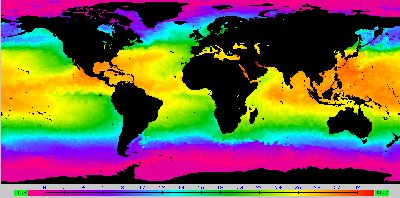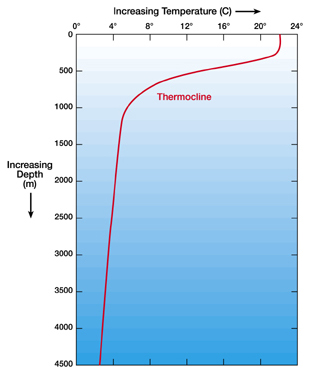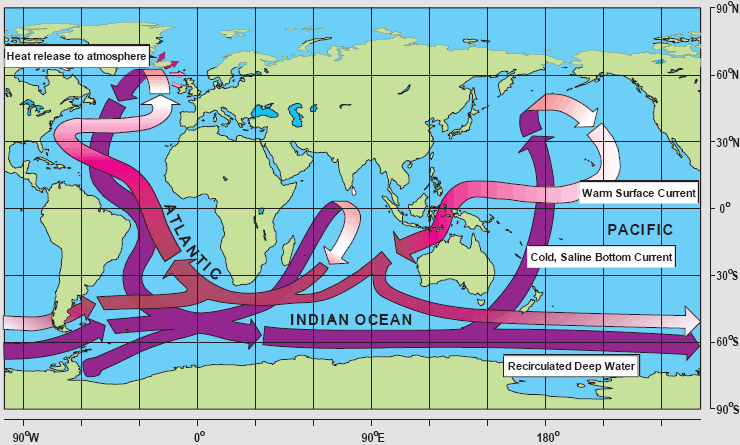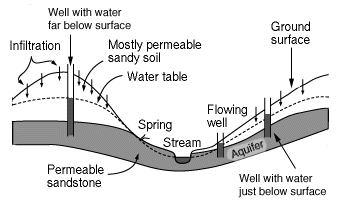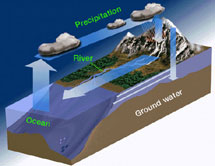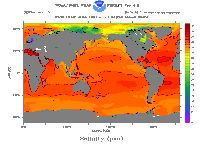Transfer and Storage of Heat in the Oceans
|
Sea surface temperatures. Pink and purple are coolest (starting near 0º C). Orange and red are warmest (up to around 32º C). |
Seasonal temperature extremes are moderated by proximity to large bodies of water for areas that are near oceans or large lakes as compared to places further inland. Water is slower to heat up and to cool down than air or even land.
Let's look at an example. The average annual temperatures in Valdivia, Chile and in Beijing, China are nearly identical. However, the average temperature in the coldest month in Valdivia is 7º C (45º F), while the average in the hottest month is 16º C (61º F). In Beijing, the average temperature in the coldest month is – 4º C (25º F), while the average in the hottest month is 26º C (79º F). The variation from winter to summer in seaside Valdivia is thus a modest 9º C (16º F), while the seasonal variation in inland Beijing is a more extreme 30º C (54º F).
Avg. Annual Temperature | Avg. Temp. in Coldest Month | Avg. Temp. in Warmest Month | Summer - Winter Temp. Range | |
| Beijing, China | 11º C (52º F) | – 4º C (25º F) | 26º C (79º F) | 30º C (54º F) |
| Valdivia, Chile | 12º C (53º F) | 7º C (45º F) | 16º C (61º F) | 9º C (16º F) |
Large bodies of water, such as Earth's oceans, have considerable "thermal inertia". They warm slowly as heat is added, but also give up that heat slowly as their surroundings cool. We are quite familiar with this principle when considering timescales on the order of a few seasons, but the same is true over longer periods of time. This is an important consideration when contemplating the extended effects of global warming.
Although slow by human standards, heating of Earth's atmosphere has progressed relatively rapidly in this current era of global warming, compared to warming of the oceans. However, ocean temperatures have also begun rising, and are not an easy thing to alter once set in motion. Our planet's recovery from its feverish condition will be delayed, once we do confront the global warming issue, by the thermal inertia of the oceans. Just as coastal regions enjoy balmy autumns, Earth will experience warmer climates for extended periods while the oceans slowly cool once (if?) we begin to diminish the factors driving global warming.
Surface Waters versus the Deep Ocean
|
This plot shows ocean temperature versus depth typical for low to mid-latitude waters. |
Complicating this issue of heat storage in the oceans is the fact that the oceans are not really just one big monolithic pool of water. From the surface, we tend to focus on the separations of the oceans in geographic terms; the Atlantic is distinct from the Pacific is distinct from the Arctic, and so on. From a heat reservoir and a "parcels of water with shared characteristics" perspective, a major distinction is between the surface ocean and the deep ocean.
In the tropics through mid-latitudes, sunlight provides a lot of heat to the uppermost layers of the ocean. However, this warming sunlight only penetrates to depths of a few tens of meters. The stirring action of wind-driven surface waves and the tides keeps the uppermost layers of the oceans well mixed, so the heat provided by the Sun is effectively distributed throughout the top few hundred meters of ocean water. However, the deeper ocean, which contains about 90% of all ocean water, does not mingle much with the surface layers. Sea surface temperatures range from slightly below freezing near the poles to an annual average near 30° C in the tropics. Deep ocean temperatures span a much more narrow range, between about 0° C and 4° C, and are nearly uniform throughout the world's oceans. A fairly sharp transition between warmer surface waters and the colder deep waters, called the thermocline, exists at depths of a few hundred meters throughout most of Earth's oceans.
What significance does this separation between surface and deep ocean waters have for climate change? Since the surface layer is exposed to the atmosphere, a warming atmosphere can effectively transfer heat to the upper layers of the ocean. Although water, due to its relatively high "thermal inertia", heats more slowly than air, we can expect that increasing air temperatures will lead to warmer surface waters over time scales of years to decades.
Of course, although surface and deep waters are not well-mixed, they do mix gradually over longer timescales. A major ocean circulation system called the thermohaline circulation plunges cool surface waters into the deep ocean, mostly in the North Atlantic and around Antarctica. The thermohaline circulation eventually raises some of the deep ocean water to the surface; mostly in the Pacific but also in the Indian Ocean. This round trip is not a quick one though; it generally takes at least a couple hundred years, and can last as long as 1,600 to 2,000 years for water that makes the longer journey to the Pacific.
The thermohaline circulation "conveyor belt". Purple arrows indicate cold, deep ocean currents. Red arrows show shallow, warm water circulation patterns. |
Heat and dissolved chemicals (including carbon dioxide from the atmosphere that dissolves into sea water at the surface) do not necessarily have to travel with a parcel of water as it makes the long journey to the deep ocean and back, but in many cases they do. So warming (or cooling) of the deep ocean will likely occur on much longer timescales than is the case for the ocean's surface layers, and on much, much longer timescales than for the atmosphere. Global warming will heat the deep ocean very slowly; but the deep ocean's recovery once we "fix" the problem (presuming we do!) will also be extremely gradual, lasting many human generations. Effects that began early during the industrial revolution in the 1800s are now being felt in the deep oceans. This time lag between climate forcings and the reactions of Earth systems to those forcing is a major feature of many aspects of global climate change that is of concern to scientists. Policies that attempt to prevent or account for further impacts from climate change need to take such lag times into account.


